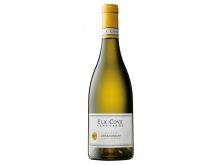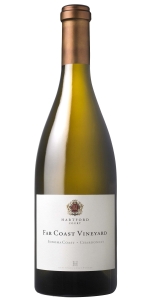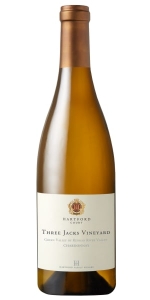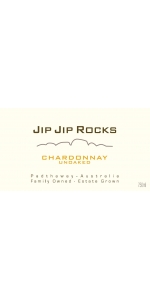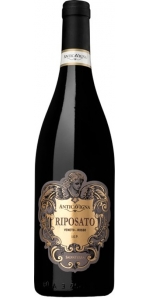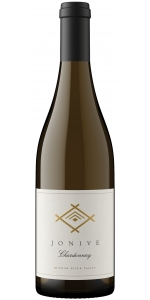Elk Cove Vineyards Goodrich Chardonnay 2019
| Country: | United States |
| Regions: | Oregon Oregon (Willamette) |
| Winery: | Elk Cove |
| Grape Type: | Chardonnay |
| Organic: | Yes |
| Vintage: | 2019 |
| Bottle Size: | 750 ml |
Argot Simpatico Ranch Chardonnay is made from 100 percent Chardonnay.
Powerful aromas of key-lime, white flowers, orange blossoms and a fierce, flinty, sauvage note define a wildly complex nose. Once in the mouth, gracefully pronounced textures coat the palate delivering an exotic interpretation of cool-climate Chardonnay character — lime peel, orange blossom, ginger and clove —lingerings deep into a vibrant finish.
Planted 1978. Shallow volcanic soils on the gently-sloped, south-facing foothills of Bennett Peak on Bennett Valley’s floor. One of California’s coolest Chardonnay vineyards. In the final year of 3-year draught cycle, Simpatico Ranch saw its earliest ever harvest and smallest crop, exposing a reserve of exoticism and minerality previously untapped. A watershed vintage for both the vineyard, and appellation. Night harvested by hand on 9/16, whole-cluster pressed direct to barrel; no settling to ensure maximum lees contact. Barrel fermented on heavy lees. Malolactic fermentation. 16 months in French oak, 50% new. Finished 2 months in steel tank, low Sulphur during barrel elevage.
Review:
There are 225 cases of the 2019 Chardonnay Simpatico Ranch, which is from a cooler, higher elevation site in Sonoma. Lots of peach, tangerine, honeyed minerality, and toasted hazelnuts all emerge from the glass, and while I don't think it matches the 2018, it's a brilliant Chardonnay offering medium to full-bodied richness, nicely integrated acidity, and a great finish. It's beautifully balanced and is going to keep for at least 5-7 years."
- Jeb Dunnuck (September 2021), 94 pts
Argot Le Rayon Vert Chardonnay is made from 100 percent Chardonnay.
"Le Rayon Vert", the phenomenon which occurs as the sun dips below the horizon, and a brilliant green flash occurs when sunlight prisms through Earth's atmosphere. Jules Verne wrote "a green which no artist could ever obtain on his palette”, akin to the ethereal, green halo all truly pedigreed Chardonnays radiate from the glass.
Wafting from the glass like a freshly opened stick of Wrigley's gum. Both intense and vibrant, the full-bodied palate delivers Granny Smith apple and stone fruits; confections of custard and sticky vanilla bean; animated by bursts of spearmint and pine forest.
Review:
The 2019 Chardonnay Le Rayon Vert comes from fruit grown on Sonoma Mountain. It slides out of the glass with graceful notes of lemon tart, lime leaves, and fresh grapefruit, leading to suggestions of almond croissant, sea spray, honeysuckle, and aniseed. The medium-bodied palate is fantastically tight-knit with gorgeous tension and layer upon layer of citrus and mineral flavors, finishing very long and chalky. This is amazing.
-The Wine Independent 97 Points
G.D. Vajra Bricco Delle Viole Barolo is made from 100 percent Nebbiolo.
The Barolo Bricco delle Viole shows the signature verticality of its vineyard. The wine is beautifully layered and - while restrained as it’s always the case in the youth of Bricco delle Viole - it also shows a complexity of layers with purple flowers, sweet spices and mineral tones. The palate is noble, with a refined acid spine and profound tannins that promise a long aging potential.
Among the historical vineyards of Barolo, Bricco delle Viole is the highest and the closest to the Alps. It rises from 400 to 480 meters above sea level, on the Western ridge of the village. Its name, “Hill of Violets”, originates from the flowers that blossom early here due to the perfect south exposure. Up above the fogs, Bricco delle Viole enjoys the earliest sunrise and the last sunset every day. Thanks to its vines dating back to 1949 and -now- 1931, a dramatic diuturnal temperature range and this pure light, Bricco delle Viole generates a sophisticated and profound Barolo DOCG of bright aromatics, chiseled tannins and subtle minerality. 2018 is a vintage that shows many nuances of Bricco delle Viole: beyond the signature verticality of this site, the wine offers high tones laced with mineral nuances and plenty of energy and youth.
Review:
A juicy Barolo, with vibrant acidity and a fluid profile that exudes cherry, raspberry, mown hay, mineral and eucalyptus aromas and flavors. Tight yet long, with excellent potential.
#26 Wine Spectator Top 100 of 2023
The last wine poured at my tasting at the winery is the G.D. Vajra 2019 Barolo Bricco delle Viole. With its high vantage point in the hills west of Barolo, Bricco delle Viole is a world apart in terms of soils (with Sant'Agata marl and fossils) and even harvest times. Slow and careful ripening like the kind that characterizes fruit in 2019 renders a very delicate and ethereal expression with floral tones, wild mint and licorice. This organic wine is solid in build and structure. Indeed, Isidoro Vaira remarks that Nebbiolo tannins have changed since the 1970s and 1980s.
-Wine Advocate 97+ Points
Jeweled in appearance, the 2019 Barolo Bricco Delle Viole may be the best wine I have tried yet from Vajra. Its gorgeous and alluring perfume of fresh roses is followed by a Burgundian, elegant red with incredible length and no harsh edges, fine and present tannins, and beautiful, graceful concentration. It is drinking well now, and I will be trying to get my hands on as much of this as possible. Drink 2025-2045.
-Jeb Dunnuck 97 Points
Hartford Court Far Coast Vineyard Chardonnay is made from 100 percent Chardonnay.
The 2019 Far Coast Vineyard Chardonnay exhibits aromas of orange zest, yellow apple, dried fruits, and spice. The flavors of tangerine, mandarin orange, and quince are followed by a long textural finish of minerals and delicate fruit.
Review:
This vineyard is located on a mountain ridge north of Fort Ross on the Sonoma Coast at 700 feet elevation, and the wine was aged for 14 months in 39% new French oak. The 2019 Chardonnay Far Coast Vineyard offers more lime citrus, saline minerality, and white peach, and the palate is fresh, energetic, and consistent with the nose. Texture-wise, it is markedly different, with more focused structure and tension.
-Jeb Dunnuck 96 Points
Hartford Court Three Jacks Chardonnay is made from 100 percent Chardonnay.
The Three Jacks Vineyard Chardonnay exhibits aromas of lemon curd, orange marmalade, and brioche, with juicy flavors of pear, candied citrus peel, chamomile, and a rich, mineral-driven texture. The wine is full-bodied, weighty, and rich yet remarkably agile on its feet because of firm underlying acidity.
Review:
The 2019 Chardonnay Three Jacks Vineyard, from vines planted in 1995, was barrel fermented and matured in 31% new French oak for 14 months. It's one of the best iterations I've tasted, combining expansive flavor and texture with precise, laser-like acidity. It offers delicate, pure scents of apricot, dried tarragon, white pepper and citrus blossoms with a stony undercurrent. The medium-bodied palate has dynamic energy from its oily texture and shimmery acidity, and it finishes with tense, mineral-driven flavors. It has much more to give as it unfurls in bottle and will be long lived in the cellar.
- Robert Parker's Wine Advocate 95 Points
SALE!
Jip Jip Rocks Chardonnay is made from 100 percent unoaked Chardonnay.
Light yellow with a pale straw hue. A classic nose of lemon, fresh stonefruit and melon. The palate is clean and fresh with mineral characters underpinning ripe pineapple and lime flavours. This wine will age beautifully over the next 4-5 years.
Winemaking report: Gentle pressing and free run juices create the base of this wine. Traditionally Jip Jip Rocks Chardonnay is a 2/3 blend fermented and matured in stainless steel and 1/3 fermented in stainless steel, which receives extended lees contact to add texture and complexity to the palate.
Review:
Attractively fruited and fragrant, the wine shows golden peach, baked fig, vanilla and lemon peel aromas on the nose, followed by a succulent palate that’s creamy and lingering. Beautifully styled and highly enjoyable. At its best: now to 2023. AU$23.00. Dec 2019.
-Wine Orbit 92 Points
Our Chardonnay is hand picked then gently whole-cluster pressed to avoid bitterness. The juice is fermented in large puncheons and a mix of neutral and new oak barrels. We age in barrel for a full 12 months with some stirring on the lees after malolactic fermentation. This is our classic take on Chardonnay, one of the original varietals we planted in 1974 and grew for over 20 years.
VINEYARD: Elk Cove Vineyards purchased Goodrich Vineyard in 2014. A 69 acre property planted with 21 acres of Pinot Noir and Chardonnay, Goodrich sits just outside the town of Yamhill, Oregon in the heart of the Yamhill-Carlton AVA. Goodrich Vineyard was planted in 2007 with Chardonnay and Pinot Noir in high-density a format. The property boasts the exact same marine sediment (Willakenzie) soil as our Mount Richmond property and lies just a few miles from our Estate Vineyard in Gaston. This young vineyard has great promise and we were so impressed by the quality of the fruit we decide
WINEMAKING: Our Chardonnay is hand picked then gently whole-cluster pressed to avoid bitterness. The juice is fermented in large puncheons and a mix of neutral and new oak barrels. We age in barrel for a full 12 months with some stirring on the lees after malolactic fermentation. This is our classic take on Chardonnay, one of the original varietals we planted in 1974 and grew for over 20 years. We’re happy to bring this varietal back to the Elk Cove family of wines.
Review:
“The 2019 Chardonnay Goodrich, from vines planted in the early 2000s, offers layered aromas of yellow apple, meringue, hazelnut, toast and honeysuckle. The medium-bodied palate is creamy and expansive, its breadth balanced by gently tangy acidity, and it boasts a long, flavorful finish. This is so pretty!” -Robert Parker’s Wine Advocate (May 2023) 94 Points
Elk Cove Vineyards was founded in 1974 by Pat and Joe Campbell. Winemaker Adam Campbell joined forces with his parents in 1995 and Elk Cove remains proudly family owned.
Early Days
It’s 1974. The Campbell family winds up a gravel road to an abandoned and overgrown homestead in the foothills of the Coast Range Mountains.
Six year old Eartha asks “Where’s the house?”
“It’s behind us!” Joe and Pat happily reply – referring to the trailer that would be their home for the next year. They are Oregon winegrowing pioneers.
Pat and Joe chose the property for its shallow soils, steep hilly terrain and beautiful views. After converting the existing homesteader’s barn into a winery, they built a new home from reclaimed lumber.
They invited friends to help on the weekends, enticing them with manual labor and wine futures. Joe worked nights in the ER, Pat managed the business, and they both worked long hours in the vineyards and made the wines together. There were fewer than ten wineries in Oregon at the time.
In the winter of 1974, a herd of 40 Roosevelt elk bedded down in the clearing by the Campbell family’s trailer. Their presence, along with the protective bowl shape of the property, inspired Pat and Joe to name their property Elk Cove Vineyards.
Family Roots
Pat’s great-grandfather was a Swiss immigrant to Helvetia, Oregon, who grew grapes and made wine prior to prohibition. Her parents were orchardists in Parkdale, a small farming community at the foot of Mount Hood. Her father Lew, upon seeing his daughter’s new land, overgrown with abandoned prune and hazelnut trees, commented “With this soil and no water, I don’t think you can grow anything here – except maybe winegrapes.”
Pat met Joe Campbell when they were both teenagers picking strawberries for spending money. He was a small town kid from Hood River, Oregon, whose smarts landed him at Harvard, then Stanford Medical School. Joe used his academic background to teach himself the science of winemaking, collaborating with other fledgeling winegrowers to learn from their achievements and struggles.
Success in a New Industry
Pat and Joe didn’t know it at the time, but they were pioneers of a new industry in Oregon.
In 1979, the Campbell’s 1978 Riesling won gold at the Oregon State Fair, the Tri-Cities Wine Festival, and the Seattle Enological Society annual tasting. Pat and Joe had proof – they really could make world class wines. In 1985 when Robert Parker of the Wine Advocate famously “discovered Oregon” the Campbells and other Oregon winemakers felt their region was finally on the map.
50 years later, there are over 1000 wineries in Oregon. The wine business now ranks as one of Oregon’s top agricultural industries.
Although Pat and Joe are retired now, you might see Pat working in the flower gardens on your visit to the winery. Joe might pour you a glass of his Condor wine. Their vision lives on through their son Adam.
The five Campbell kids all grew up working summers in the vineyards at Elk Cove – it was truly a family business and Joe and Pat needed all the help they could get. Adam took a special interest and stayed close to home for college, attending Lewis & Clark and spending summers on the bottling line. Upon graduation he joined the business year-round to learn the craft of winemaking from his parents.
Adam is now responsible for making Elk Cove’s wines. He now oversees six vineyard sites with 380 planted acres. That’s over 10 times the total acreage of all Oregon vineyards when Pat and Joe planted that very first vine in 1974.
The Campbells’ goal has always been hand-crafted, Estate-grown cool climate wines that rival the best in the world. As a second-generation winemaker and a 5th-generation Oregon farmer, Adam Campbell is proud to continue that tradition.
Ancient Vineyard Rested Veneto Red
bright ruby color. The nose evolves bright cherry, wildberries, and a touch of spice. The palate is deep and rich, with a long-lasting finish.
Jonive Chardonnay Russian River Valley is made from 100 percent Chardonnay.
2021 Jonive Russian River Estate Chardonnay: Harvested the night of September 20th with the two clones kept separate. The clone 95 was pressed into tank where it was chilled, settled and racked, then allowed to ferment naturally for 12 days when it then went to barrel. The primary and secondary fermentations lasted in barrel until April 20th, some seven months. The wine remained on its original lees until just prior to bottling. The clone 17/Robert Young chardonnay was pressed into tank and allowed to brown naturally before a natural fermentation occurred. This lasted for 15 days before going to barrel where it finished the last 12 days of primary fermentation and six weeks of secondary fermentation and it too rested on its original lees until just prior to bottling.
The wine has a typical straw color and complex aromas of lemongrass, nutmeg, Meyer lemon and a touch of passionfruit. It has an enveloping mouthfeel that is at once tart and linear as well as rich and expansive, a very unusual and beguiling combination of textures and mouthfeel. The browning of the clone 17 enables the wine to be rich, but at a lower alcohol (13.3%) and the clone 95 contributes beautifully fresh acidity. The pallet shows jasmine, honeydew melon, tarragon and lemongrass with a nice kiss of high-quality French oak. The extended lees contact gives the wine amazing length, energy and vitality.
353 cases produced
Harvested September 20th
14-month barrel aging in 67% new French oak barrels, 20% once used and 13% neutral
61% clone 17/Robert Young and 39% clone 95
13.3% alcohol
Bottled December 14th
Reviews:
A wildly elegant aromatic profile announces this Chardonnay from Jonive's estate vineyards, a combination of two separately fermented clones, 95 and clone 17, also known as Robert Young. The blend is beautiful and effusively aromatic. Lemon cream and white flowers mark the aromatic profile, and the palate, crafted with plenty of lees contact, shows a creamy texture of lemon and orange oils. Savoury notes of sorrel and lemongrass mark the lengthy finish. The new French oak kisses this wine just a touch with a note of Madagascar vanilla on the finish.
-Decanter 94 Points
This seamless, smooth and mouthfilling wine is packed with ripe fruit flavors and deftly accented with oak notes like vanilla, hazelnut and toast. It's rich in texture yet relatively light in body, encouraging flavors that mingle with a subtlety that asks for more sipping.
-Wine Enthusiast 94 Points
- back
We are delighted to offer our first Beckstoffer Georges III bottling in many years. The spectacular vineyard site with its back to the Silverado Trail is the historic site of the grand old BV masterpieces produced for most of the last century. It is as pure an expression of Napa Valley terroir as is available anywhere, from anyone. Ripe and round black fruits, spice, blueberry, and cedar, and cigar box aromas are echoed on the palate and balanced by a preternatural lift from natural acidity and a swell of earth notes. A stunning achievement.
Review:
Thick in sage brush, dried herb and earth, this wine is powerfully built and unabashedly ripe. Dark black fruit, mocha and graphite notes arise along the thick, intense palate, leading to finishing touches of slate and iron. Cellaring will help to tame the tannins; enjoy from 2028–2035.
-Cellar Selection Wine Enthusiast 94 Points
A complex Carignan mixing black fruits and spices. Intense color and fine structure with rounded tannins and volume in the mouth.
RS: 2g/L
The fruit was carefully sorted to ensure only healthy, ripe grapes were vinified. Traditional fermentation took place in stainless steel tanks at controlled temperatures of 28°C with selected yeasts. Remontage or pump overs took place periodically to oxygenate the wine and extract tannins. A short post-fermentation maceration took place to extract color, flavor and impart structure to the wine. Ageing in stainless steel preserved the integrity of the pure fruit character. The wine was lightly filtered before bottling.

